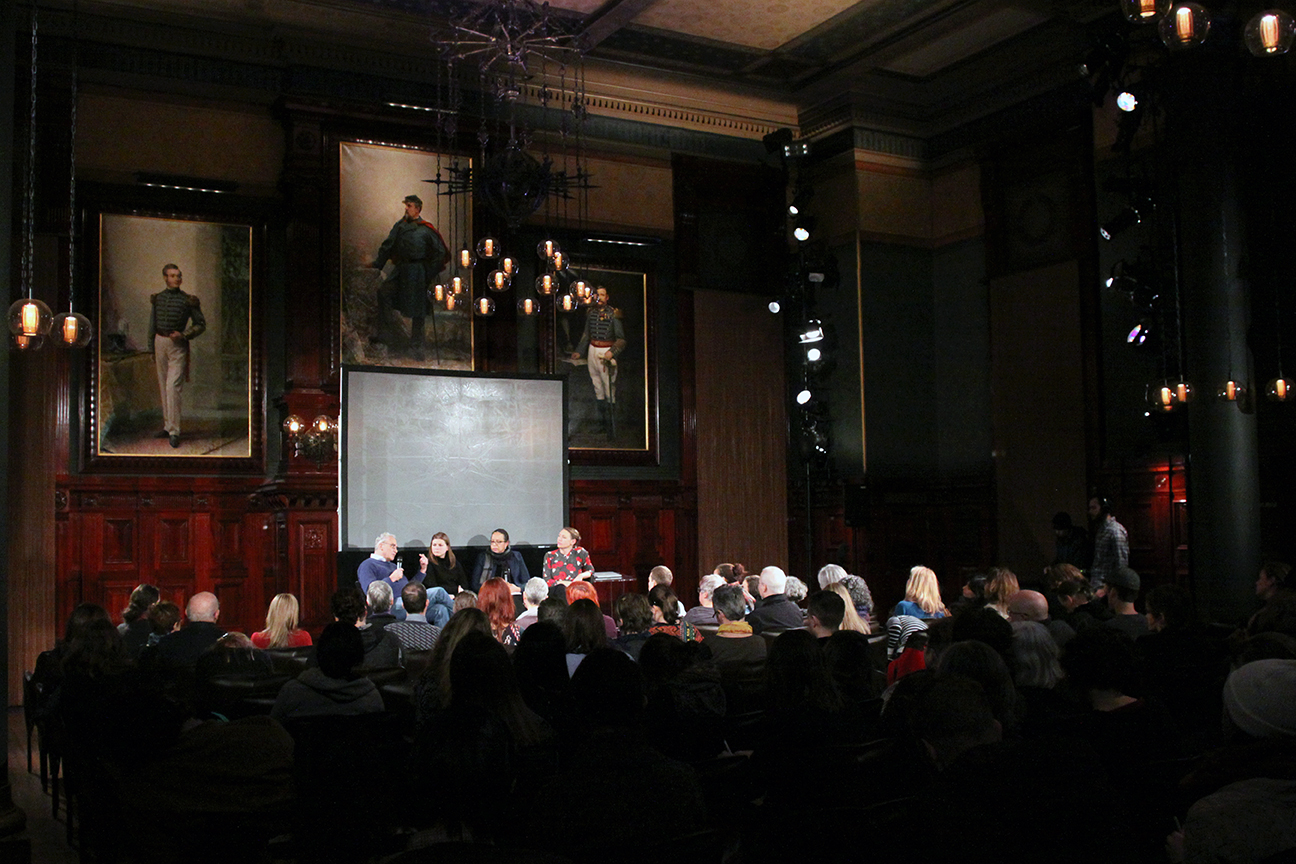On the Functions and Fallibilities of Art in Education and Education in Art
ART21 Screening & Panel Discussion
This Friday night conversation set the stage for Creative Chemistries. Three art professionals joined moderator Jess Hamlin in tackling ideas and questions about art education today, the functions of art, the roles of artists and educators, and the possibilities for reimagining existing structures to meet today’s social and political needs.
Using this half-hour of ART21 video clips above as a jumping-off point, the night served as launch pad for the provocative, in-depth conversations and experiments that followed on Saturday.
Committing to the intersections of art & education
ART21’s Director of Educational Initiatives and moderator, Jess Hamlin begins by explaining the “massive gap” she’s found between the ways artists talk about their approaches to thinking and making art, and the ways she was taught to think about and engage with art as a place. In an attempt to uncover the panel’s distinct perspectives on parsing the connections between art and education, she asks each member to begin by explaining the investment she or he has made to the intersection of art and education.
In this introduction of panel members, each explains in an autobiographical sense the ways in which they came to dedicate themselves to art and the educational environment surrounding it.
Sandra Jackson-Dumont
Sandra worked for the Studio Museum in Harlem and the Whitney Museum of American Art before spending nearly ten years as the Deputy Director for Education and Public Programs at the Seattle Art Museum. In 2014 she joined the Metropolitan Museum of Art as the Fredrick P. and Sandra R. Rose Chairman of Education, where she oversees all of the Museum’s education programs including school and teacher programs, lectures and gallery talks and gallery and studio programs.
For Sandra, education meant freedom. She grew up in an under-resourced community in San Francisco and her first artistic influences were dance teachers and artists invested in social practice, back then referred to as “community artists.”
“For me, I think working at the intersection of art and education is really about freedom, and it’s also a social justice act. I think it’s an equity issue, because it’s about the freedom to be able to think critically about the world you live in, but also have the tools through an education system that provides you the ability to think in a way that allows you to navigate the world for yourself.
Working in museums is a really interesting place because they are historically charged as these places that are in opposition to the everyday person… I’m interested in the history of artists shifting that paradigm. I’m also interested in the history of people and protest against museums. That protest is not just because one feels that you did something wrong, but it’s about a legacy. Like, ‘Why am I not there, on those walls, painted that way? Why was I not socially involved in this space?’
So it all goes back to the idea of access equity and the ability to think and be free in ourselves and in the societies we work in. I also don’t have children, so I always get asked that question. ‘Why are you interested in education? You don’t have kids, right?’ I’m like, ‘I care who I ride the bus with, that’s why.’”
Rebecca Belleville
Working as an Art Educator for the Baltimore Design School for more than six years, Rebecca has also served as a Seminar Instructor for educational inequality nonprofit TNTP (The New Teacher Project), training new art educators after receiving her own MA in Art Education from Maryland Institute College of Art.
Rebecca always considered herself an outsider in terms of traditional arts education. She’d only had one art teacher before attending an arts college, and had never received any formal training as an art educator when she first began teaching. Instead she was schooled as a painter and went through an alternative certification route to become an educator in Baltimore city schools.
“I just think about the need for critical thinking, and I see my students reaching and trying things and being free in a way. And in the other classrooms, teaching to the test and this kind of rote memorization of the right answer, is just so detrimental and destructive.
So my commitment is to the kids actually being able to think, and that sounds ridiculous and very low, but it’s amazing to me how my students struggle to think on their own…
Like when I don’t give a lot of criteria, their brains explode… And so that structure is, I think, very, very important and not what our students have access to, and don’t give themselves access to. So that’s my commitment. I’m just helping your bus friends think critically.”
Luis Camnitzer
As a German-born Uruguayan artist, Luis moved to New York in 1964 where he co-founded the New York Graphic Workshop, a printmaking studio exploring the use conceptualism in prints. In the years since he’s developed his own form of Conceptual art that investigates language and socio-political injustices. His work can be found in the permanent collections of the MoMA, the Met, the Whitney and the Guggenheim, along with dozens of other museums across the globe.
“I think that art thinking is… a matter of discipline that should be merged into all other disciplines.
And in fact for me science is a sub-product of art thinking. Science is bound by certain rules, by cause and effect, by repeatability, by experimentation. Art has all of that and all the opposites as well, which means art is an umbrella and that’s what should be merging into all other activities.
And I don’t care that much about the formal art training that happens in art schools; I care more about the integration of art thinking into everything else, to break down the disciplines, to break down dogmas, and in that sense we end up agreeing. And focus really on how do you expand knowledge in a creative way, in anything you do, rather than how do you make a cute painting that hangs on the wall.”
All the panelists were deeply affected and inspired by their earliest educations in the arts – moderator Jess Hamlin noted that they’re all attempting to “provide the antidote” to the ways in which traditional education failed them.
Evolution & experiential freedom within art educational contexts
Next our panelists address the ways in which the museum space works to engage its visitors. They speak about how their own work attempts to solve the paradox of featuring and producing innovative ‘outside-the-box’ art, while the framework in which artists and art professionals are trained remains rigidly dogmatic and technical.
Rebecca Belleville – “Because let’s be honest, what we’re doing to our students of color and our students of poverty is not working. They are not being educated; they are not being readied for anything but food service. And I can’t stand behind that, and I can’t sit here and say that art education is the answer, when we as a people know that there’s more to this…
How do I actually make these things attainable so that students are fixing what has been broken for them, and they’re not just a product.”
Art & artists as agents of social change
Teaching everyone how to draw or paint won’t solve our country’s systemic educational problems, but giving students different perspectives on how to analyze the social institutions that surround them just might. Art that creates a dialogue with the community that played a role in its creation engages socially in a way that pure aesthetics can’t. Here the panelists discuss what “art” means to them, and the ways in which politically charged art has the power to foster change.
Rebecca Belleville – “Force Upsetting Rape Culture, they have this monument quilt and what they are doing is actively consulting survivors and having them speak. So just allowing them the space to speak and quilt and create is a political act, right? Like Mark Bradford was saying, black bodies in a room is a political act. The voice of those who have been silenced is a political act…
There was a prison [the Tamms Supermax in Southern Illinois] that had indefinite solitary confinement… The “worst of the worst” were moved to this prison where they had potentially indefinite solitary confinement. And some of these men were in solitary for 14 years, 17 years.
So she [Mary Jo Reynolds] began a poetry-writing campaign…to have people write poetry to these inmates. One of the inmates wrote back, “This is great but we’ve got real issues, you know, poetry’s not gonna solve this.” And so through that she really started the legislative work, and she started lobbying with the mothers and wives and other family members of the inmates, and got this supermax prison shut down.
So I think of that, which she coins as legislative art. A lot of people have questioned whether or not that is art, because there’ve been curated shows that show the artifacts from that process combined. I think about that, and that kinda hits home. That hits close to home. Activist ideals… This idea of a product, not so much. It’s the thought process…
Just by installing these thought processes [in students] is what then allows them to be more open and free with their investigations, just as a scientist or as an artist would be investigating a process… And again it is frustrating to some people, and that’s not to say I’m like this loosey goosey art teacher that’s just like, ‘Whatever you want, kids.’
But to instill in them that this is art, this thought process is art, and it may or may not contain a product at the end, but these questions are necessary and it’s the role of the artist to be asking these and creating societal change because of them.“
Luis Camnitzer – “I think one of the basic premises is to suspend the word ‘art,’ leave it out of the question, and try to figure out why do we need the word. And I mean it’s such an ambiguous word, it has so many meanings, and we just throw it and cover everything with that, and then people take whatever they want and we don’t communicate.
So one problem is the canon that is behind the work of art, and in that sense there is an oxymoronic activity here, in which the institution is trying to conserve, promote, and consume the canon, and a good education would be fighting all that structure and challenge the canon. And it’s like a good religion creates heretics, and doesn’t create dogmatic followers.
And museums tend not to understand that. So the function of a good education program… would be OK, how do we create as many heretics as possible, so that the canon can be shifted, can be adapted, and can be owned by the people that should own it, and not by the social class that finances through sporadic philanthropy and censorship? What is to be called good, and make it memorable? And once you are in the museum you automatically are declared as valid. And it’s really the invalidity – the fragile borderline – that becomes interesting and generates new thought…
Ultimately, the ideal of what we do is to eliminate art education from the educational curriculum and have the idea of creating alternative orders of connecting and integrating in illegal ways, orders that are not supposed to be connected.
And with that generate new knowledge, and that’s what I call art thinking, to have that happen in the whole educational system. And by what they call in transformation education ‘disorienting dilemmas,’ have students engage in real critical thinking and make the decision about what the next step is. And therefore from the beginning, start creating in whatever fields they are [in].”
Art as a means of failure & perseverance
Presenting solutions on how to best adapt our social institutions to address forgotten needs includes a pervasive element of trial and error. Here the panelists discuss the ways in which art has the potential to teach about failure and perseverance.
Sandra Jackson-Dumont – “…We all know what it feels like not to feel accepted by the normative or what dominant society is kind of stating. And that’s what failure is: it’s the dominant thing that people feel is judging them in their daily lives.
But I’m going to read this – all things go back to Baldwin for me, by the way. The paradox of education is precisely this… These are Baldwin’s words: ‘That as one begins to become conscious, one begins to examine the society in which he is being educated. The purpose of education finally is to create in a person the ability to look at the world for himself, to make his own decisions. To say to himself that this is black, or this is white. To decide for himself whether God is in Heaven or not. To ask questions of the universe and then learn to live with those questions…’”
Luis Camnitzer – “…The notion of failure is a very linear notion, because it neglects to see that failure is relative to one set of norms that determine that it’s failure. But failure for one thing may be success for something else. So when you fail, so-called, you go and identify, OK, this same failure for this, what could it be success for in other terms?
So you look for a problem to which that solution fits, which is a typical process in art actually. That is, you don’t know if you start with a problem or you start with a solution. So the idea of failure only exists once you are fixed on a particular problem, and the solution doesn’t fit.”
Rebecca Belleville – “In terms of the classroom, I find that with my students there’s a couple of different things. There’s either an unwillingness to even experiment because they don’t want to fail, so they won’t even try… Or there’s another realm of, ‘Well I did it. Isn’t that what you wanted? I did it.’
So really I’ve been kind of emphasizing the iterative process, the design thinking process. And then also studio habits of mind. And by doing that I find that there’s going to be a breakdown in the classroom – nine times out of ten you’re going to have tears somewhere, because something that they did at one point didn’t fulfill some portion of the assignment… and them coming to the realization that they had put in this work and that they’ll just need to put in more work is really crippling sometimes.
But just being there and supporting them and allowing them to cry and taking them outside and telling them how proud you are of them… they just want to know that you’re there and you care about them.”
Addressing students’ needs
How can educators strike a balance between what students want (which is usually very focused on the end-product) and what teachers want them to learn and get out of a class? The panelists discuss the possibility of a holistic approach to art education that encompasses theory and technique, and the resources available to get them there.
Sandra Jackson-Dumont – “…At the Met there’s this program called the Astor Educators… Fifteen teachers get together as a cohort and they study and work together for the entire year, and they get subsidized to do so. And they get all these resources and the best minds… So they’re actually spending time thinking. As a high school teacher I didn’t have that time, and I also felt pressed to shorten my own creative thinking because I knew that when the students ended their day with me, at the end of the academic year, that accumulation of days with me needed to result in something. Because let’s face it, teachers are also dealing with needing to pay their rent…
Look to museums, look to places like Art21, look to artists, look to other organizations you’re working with, to create environments for you. And they exist, and they’re deep and really well rooted, and have tons of resources… You’d be surprised how many people will pay you to think.”
Rebecca Belleville – “Baltimore City Professional Developments were horrible… and it made me so angry because everybody that would come up and present for professional developments in front of – we have probably 150 art teachers in Baltimore City – they were so negative about everything, they’re like, ‘Well this is what the district is making us do, and Race To The Top funds are making us focus on assessment.’ And everyone was so angry about what we were doing up front, and it left everybody even more frustrated, as if you didn’t have enough stressors working in Baltimore City schools…
So I got really frustrated with that and I started trying to take over the PDs and… I just try to present everything – not as some like fake happy person by any means, but present things that I’m passionate about and interested in. And I’ve noticed that art teachers have started kind of grouping, and we’ve [been having] these breakout sessions on our free time of curriculum writing and trying to figure things out, and then through that there’ve been partnerships with MICA (Maryland Institute College of Art) for other classes…
It’s just really about utilizing what you have to offer as an individual, both in your personal, and then as the collective like what can you offer others and how can you motivate others… And I know that that may not change the day to day in the classroom, but feeling like there’s a sense of community, even as ephemeral as like one day out of every two months, I think it really lends itself to something greater.”
Friday, February 20th 2015
7:00pm
Topics discussed:
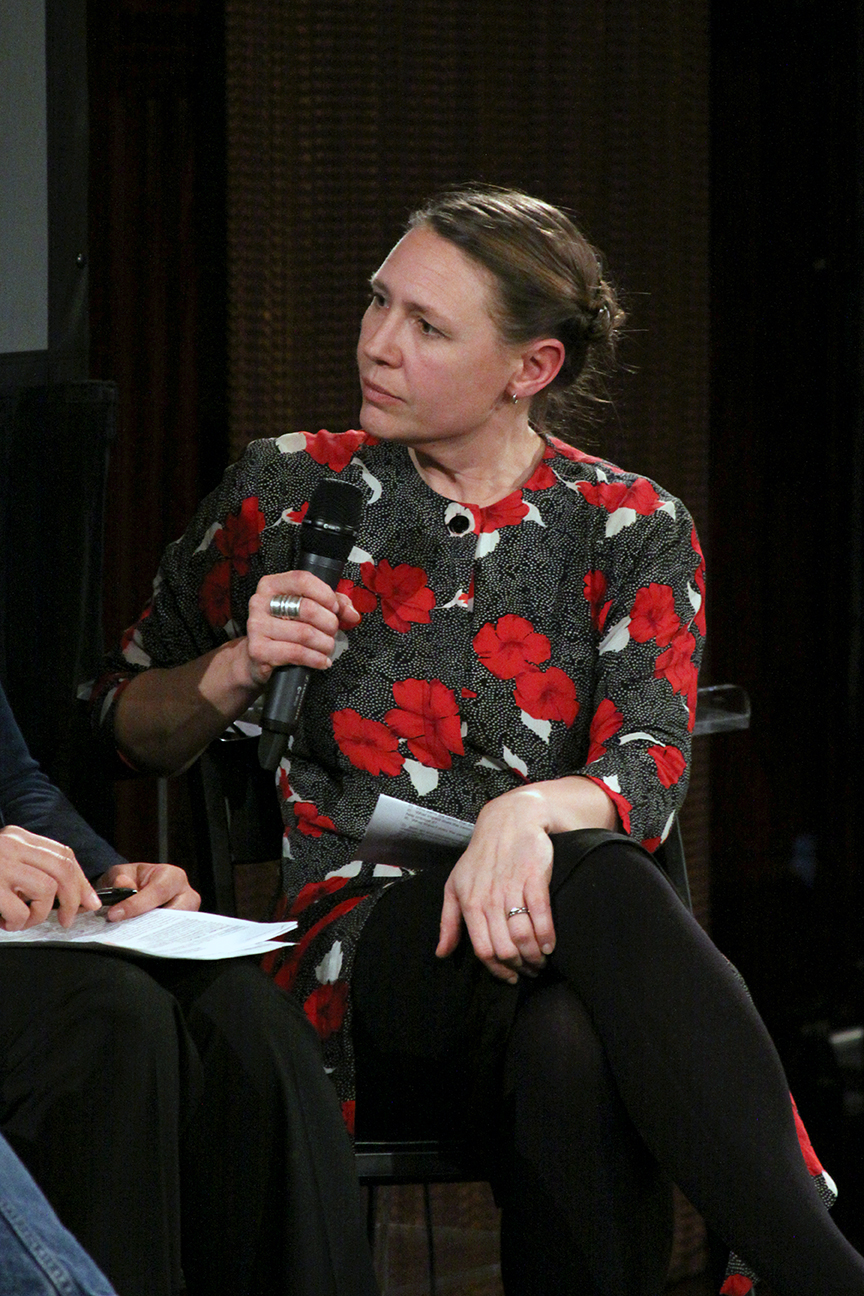
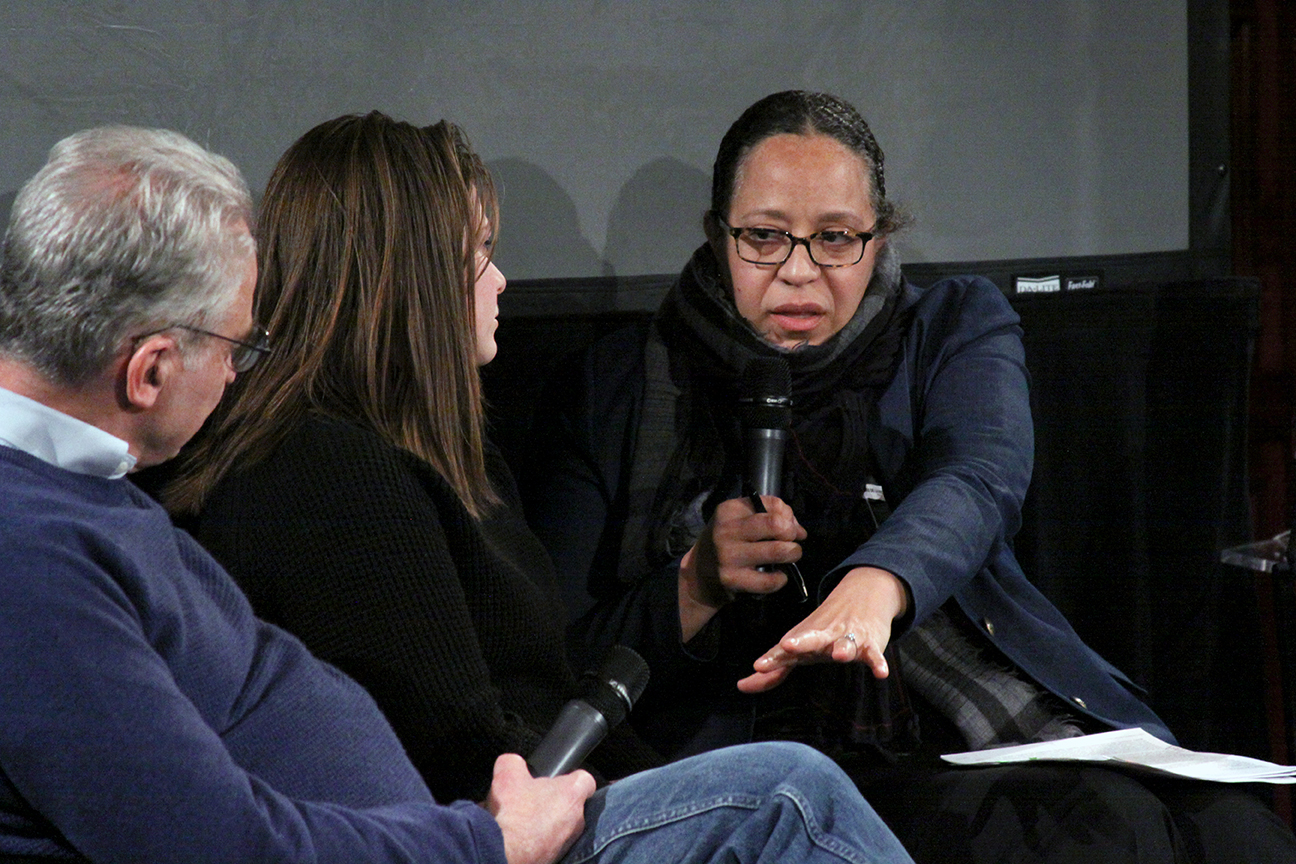
I also don’t have children, so I always get asked that question. ‘Why are you interested in education? You don’t have kids, right?’ I’m like, ‘I care who I ride the bus with, that’s why.’
—Sandra Jackson-Dumont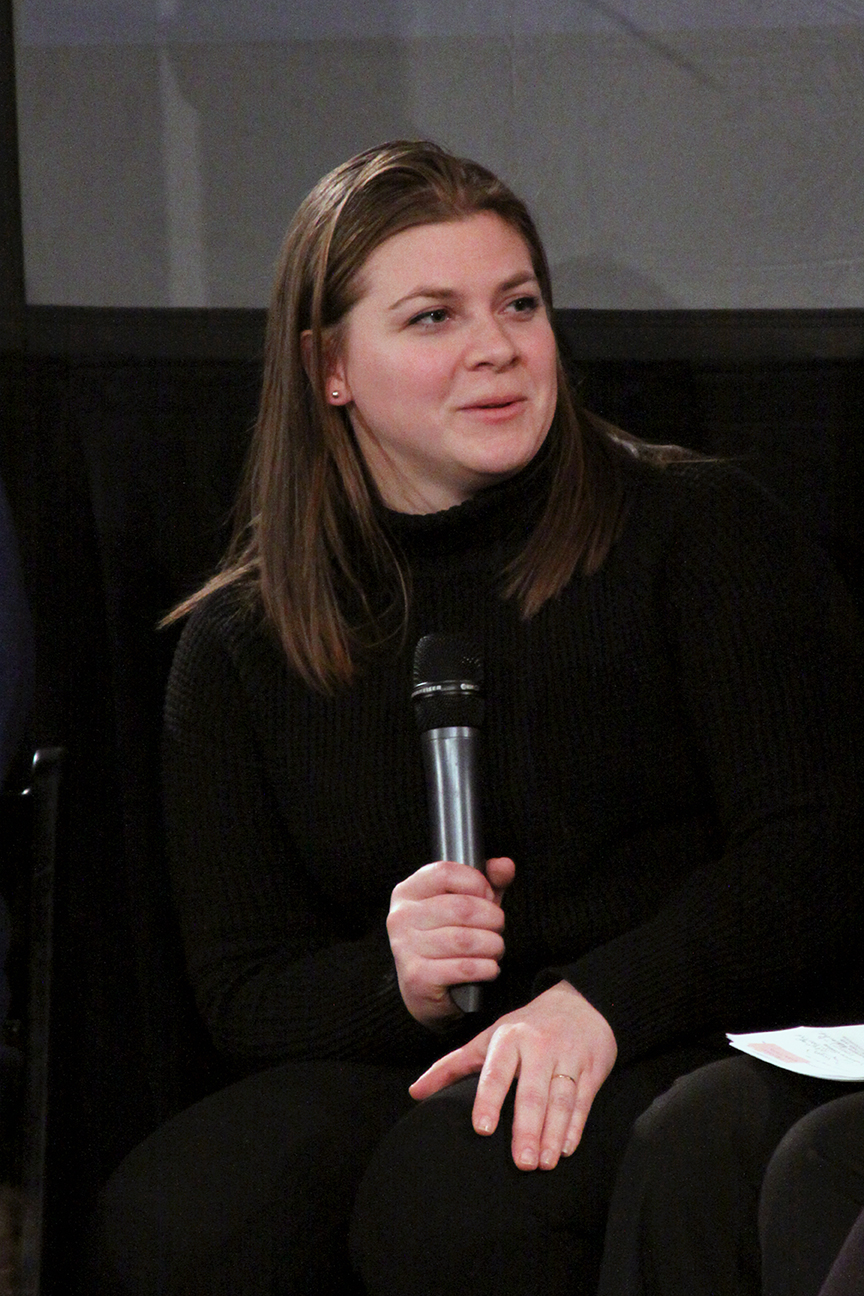

Luis Camnitzer. The Photograph, 1981
Science is bound by certain rules, by cause and effect, by repeatability, by experimentation.
Art has all of that and all the opposites as well, which means art is an umbrella and that’s what should be merging into all other activities.
— Luis Camnitzer
And I don’t care that much about the formal art training that happens in art schools; I care more about the integration of art thinking into everything else, to break down the disciplines, to break down dogmas, and in that sense we end up agreeing.
—Luis Camnitzer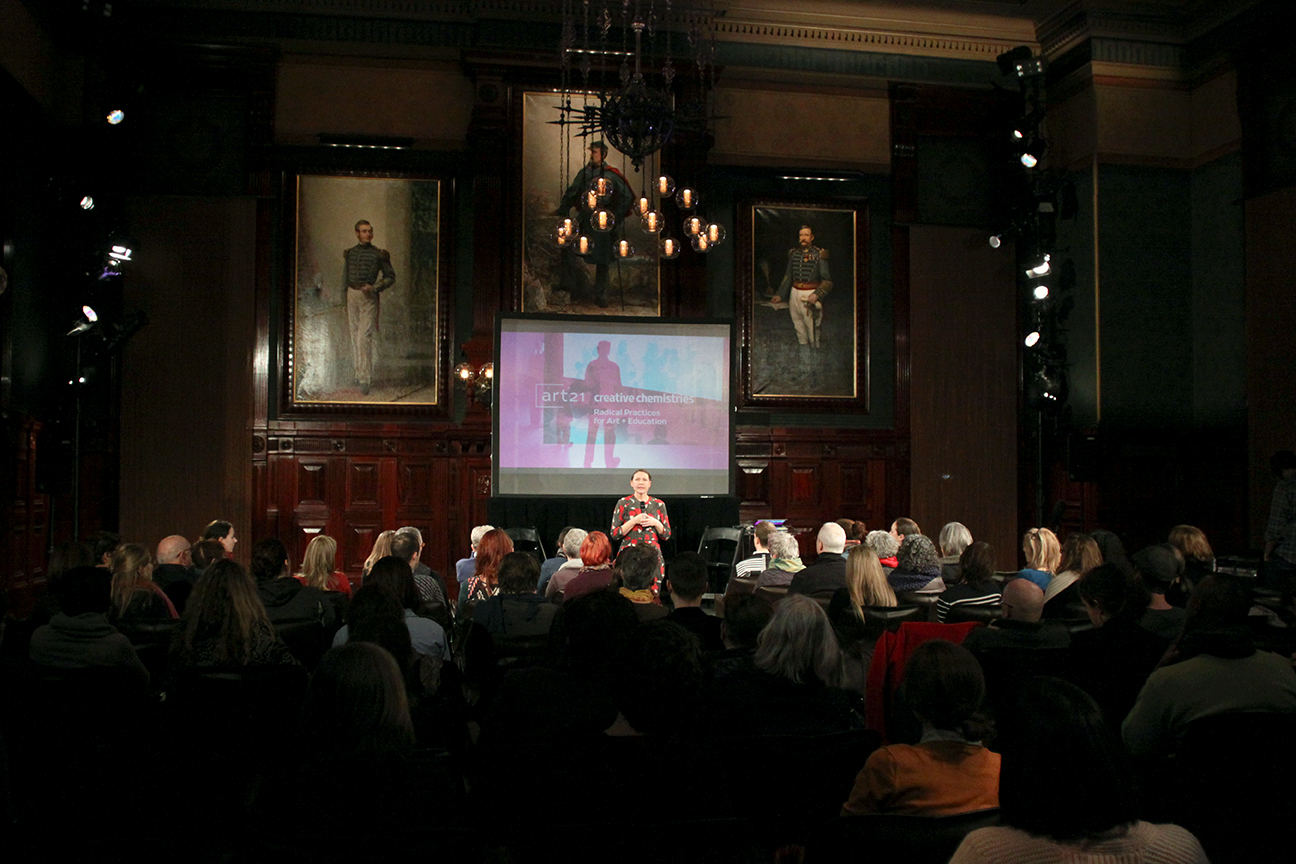
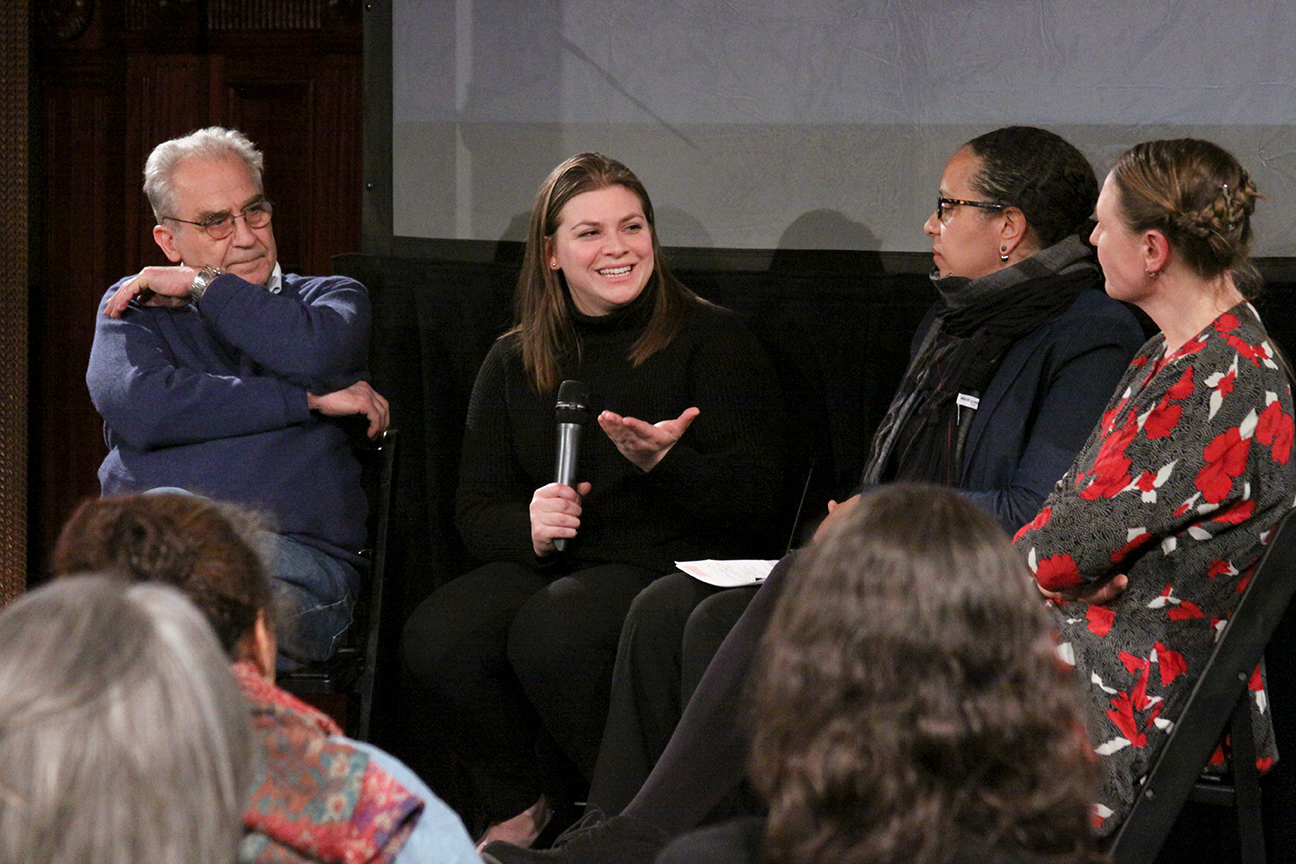
What we’re doing to our students of color and our students of poverty is not working.
They are not being educated; they are not being readied for anything but food service.
And I can’t stand behind that…
—Rebecca Belleville

So the function of a good education program… would be OK, how do we create as many heretics as possible, so that the canon can be shifted, can be adapted, and can be owned by the people that should own it, and not by the social class that finances through sporadic philanthropy and censorship?
—Luis Camnitzer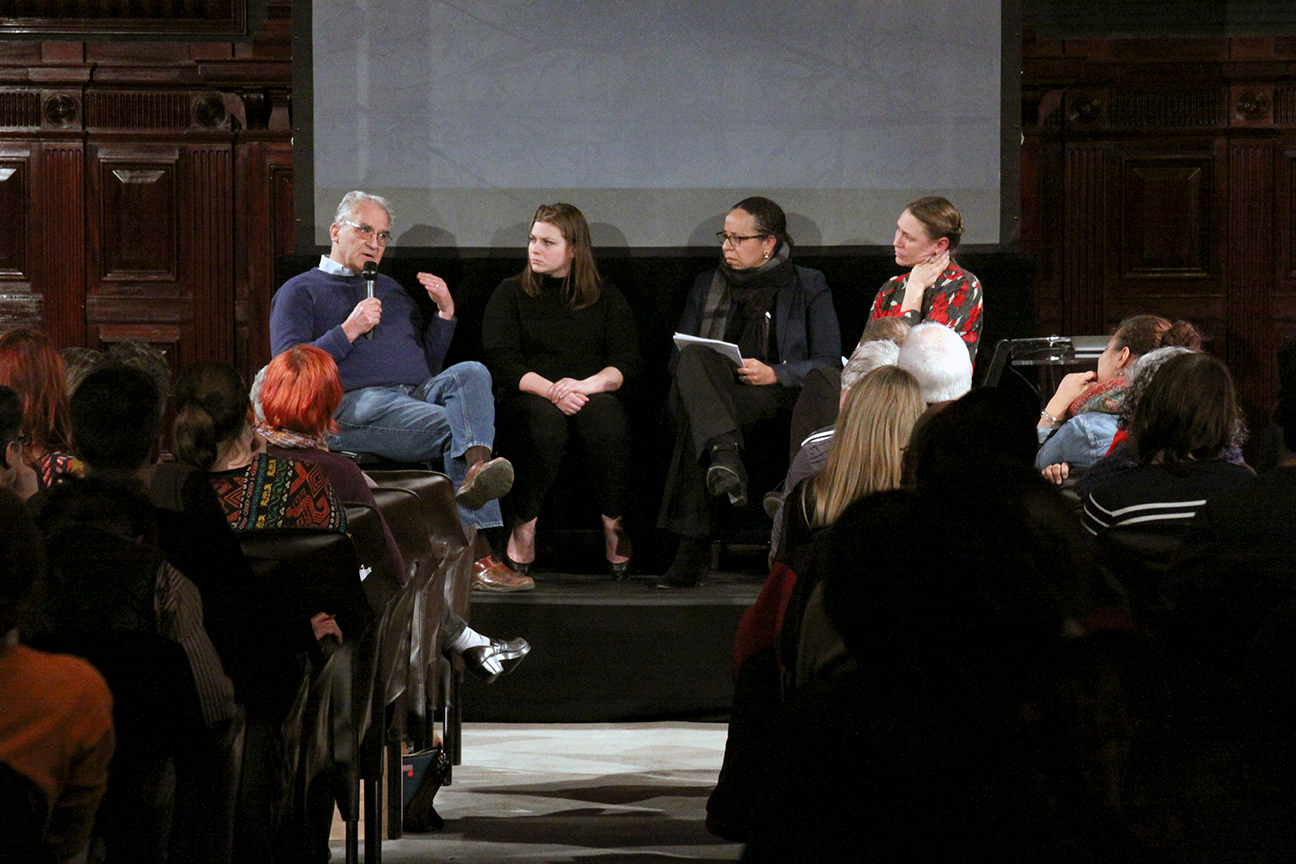

The paradox of education is precisely this… These are Baldwin’s words: ‘That as one begins to become conscious, one begins to examine the society in which he is being educated.
The purpose of education finally is to create in a person the ability to look at the world for himself, to make his own decisions.’
—Sandra Jackson-Dumont
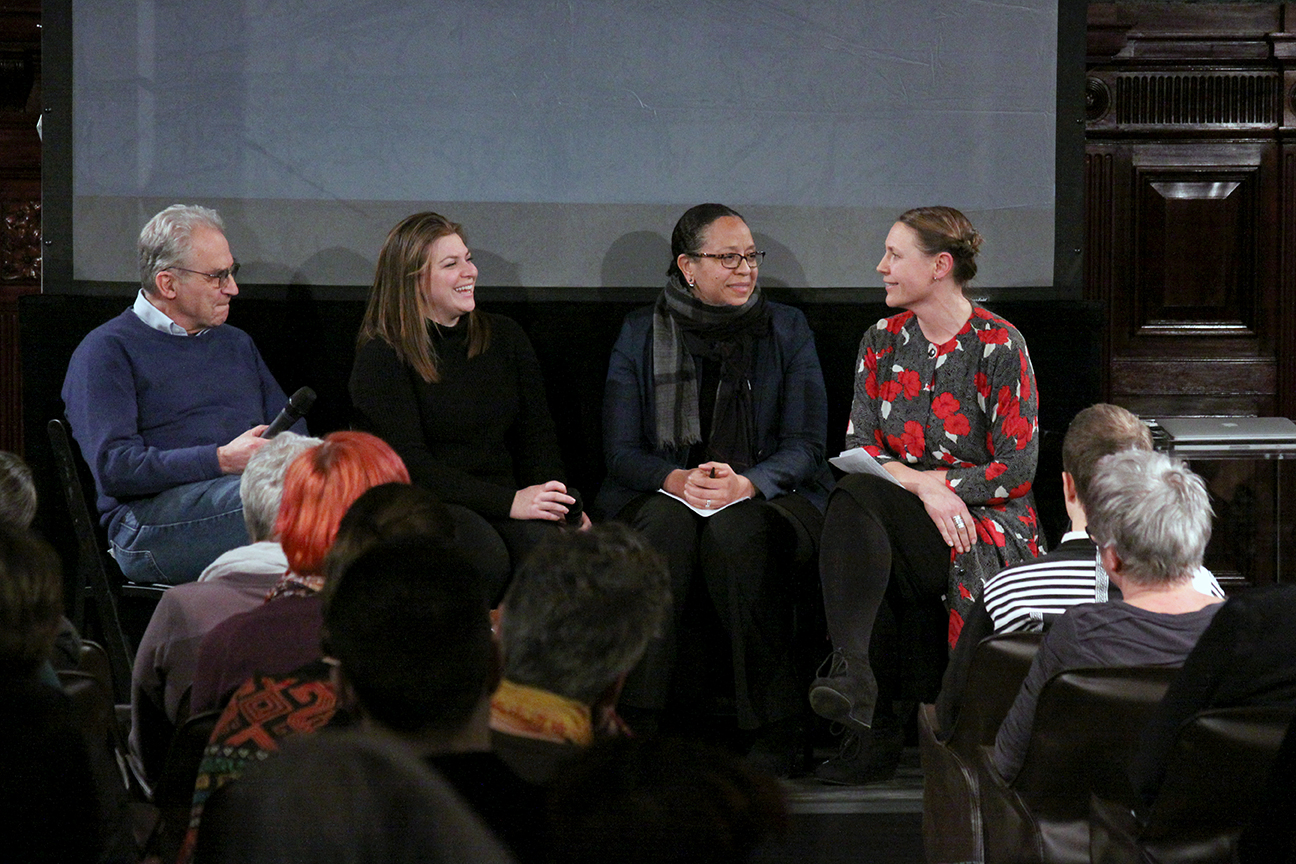
Look to museums, look to places like Art21, look to artists, look to other organizations you’re working with, to create environments for you. And they exist, and they’re deep and really well rooted, and have tons of resources…
You’d be surprised how many people will pay you to think.
—Sandra Jackson-Dumont
It’s just really about utilizing what you have to offer as an individual, both in your personal, and then as the collective…
And I know that that may not change the day to day in the classroom, but feeling like there’s a sense of community, even as ephemeral as like one day out of every two months, I think it really lends itself to something greater…
—Rebecca Belleville

